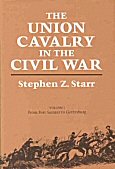
STARR : The Union Cavalry in the Civil War (előszó)
GLAMOR WAS THE WORD FOR THE CAVALRY WHEN THE Civil War broke out. The middle years of the nineteenth century were a time of overripe romanticism. Otherwise sober men, a generation or two removed from an utterly unromantic frontier, saw the cavalry through the eyes of Sir Walter Scott and themselves in the role of the mailed knight wielding a saber, with its finesounding French name, the "arme blanche," the true weapon for man-to-man combat, unlike the impersonal, unwieldy, plebeian musket of the lowly infantryman. Beyond argument was the immense superiority of a man riding a steed—not a mere horse—into battle, over the heavily laden footsoldier, slogging his dreary way through ankle-deep, viscous mud.
Precious few of these gaudy visions survived the realities of the first few months of a cavalryman's exposure to the service. The steed turned out to be an untrained, unmanageable scarecrow, requiring an inordinate amount of care; except on parade, the saber generally stayed in its rusty scabbard, since much of the fighting was on foot. And the yellow cavalry trim on jacket and trousers became tarnished and blackened with dirt and the smoke of campfires.
In no time at all, the glamor evaporated. In its place came a life of hardship impossible to realize fully a hundred and twenty years later, compounded of exposure, filth, an unspeakable diet, medical care primitive even by the standards of the day, disease, disability, and death. For those who survived the hazards of mere existence in the army, there were the additional hazards of skirmish and battle, magnífied by derisory training and inexperienced or downright poor leadership. On the home front, however, the glamor of the cavalry led a charmed life. In the postwar years especially, the story of the cavalry in the Civil War acquired a halo of romance and became the object of a never-ending fascination, fueled by a stream of books glorifying the more spectacular deeds and personalities, both real and idealized, of the cavalry on both sides, and decade after decade, this fascination has continued to flourish.
The purpose of the present study is to describe the cavalry and its military role in the Civil War as realistically as the mass of surviving records, official and persorral, will allow. For obvious reasons—ars longa, vita brevis holds true for the reader as well as the author—the protagonist is the northern cavalry, and the southern cavalry is considered only to the extent needed to present a rounded picture.
I have been living with the Federal cavalry for flfteen rewarding years. In my mind, as in the minds of the men I write about, the cavalry glamor went up in smoke long ago, to be replaced by a two-fold vision that this study endeavors to express. First is the intellectual fascination of observing the emergence from the slough of despond of a misunderstood, misused, untrained, and inept branch of the service and its development through a process of sheer pragmatism, of unarticulated ideas bubbling up from below, into the cutting edge of the Federal armies. In the last year of the war, when attrition, the discharge of time-expired veterans, and other factors caused a steady deterioration in the quality of the Federal infantry, particularly in the East, the blue cavalry came into its own, well led, equally skillful whether fighting on foot or on horseback, battlewise, tough, true veterans, fighting men of superb quality. The second aspect is primarily emotional: an unbounded admiration for the men—boys, many of them, sixteen, seventeen, and eighteen years old—of the Federal cavalry. Not all of them were heroes by any means; the cavalry had its share of deserters, cowards, malingerers, thieves, misfits, the stupid, the drunkards, and the shirkers, and they were to be found in every rank, but it is impossible to live with these men in spirit without an ever-growing respect for their hardihood and dedication.
It needed a true nobility of spirit (an expression most cavalrymen would have laughed at) for a regiment of cavalry to vote in the 1864 presidential election, as did the 2nd Ohio Cavalry, 201 for Lincoln and 4 for McClellan, and to glory in having done so. Their vote was a deliberate expression of their determination to see the war fought to a finish. They well knew when they cast their ballots that if the war was to continue, they themselves would have to bear the brunt of the fighting and the dying.
Partly because of my admiration for these men and partly because of my personal predilections, I have endeavored to tell the story of the Union cavalry primarily in terms of its personnel, from general to latest-come recruit, and have done so whenever possible in their own words. The campaigns, battles, and tactical developments are indispensable, and I hope I have done them justice, but I believe, and hope readers wíll agree, that more than a hundred years after Appomattox, the men behind these events and trends—who they were, how they lived and died, what they experienced, how they behaved, what they said and thought—are no less important, and as worthy of study, as the events themselves.
[...]